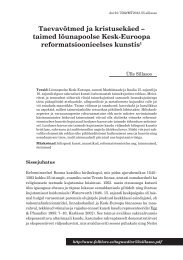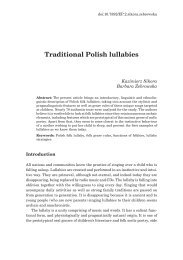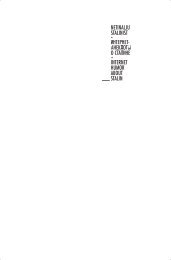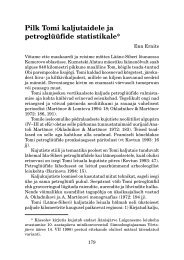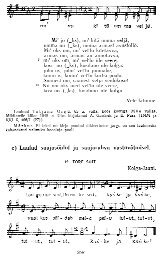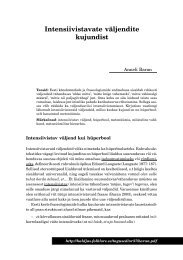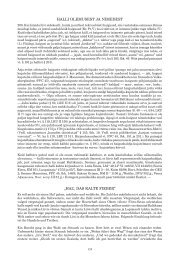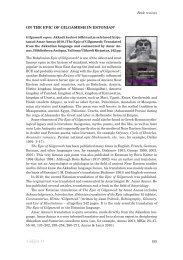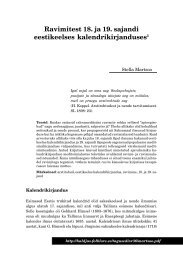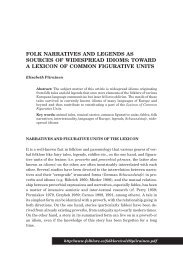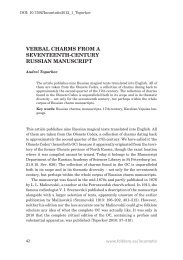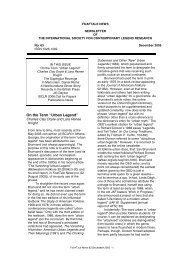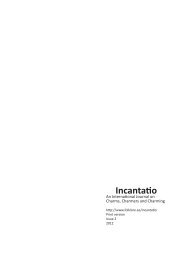- Page 2: Media & Folklore Contemporary Folkl
- Page 5 and 6: 4 Editor Mare Kõiva Language edito
- Page 7 and 8: 6 PRESS Maarja Lõhmus 185 Mediamyt
- Page 9: egion. The focus of her research wa
- Page 14 and 15: Das Handy - oder: vom erzählerisch
- Page 16 and 17: Dazu paßt der Bericht, den mir ein
- Page 18 and 19: te - wie die Gesellschaft für deut
- Page 20 and 21: wickelten, entlegenen Regionen spre
- Page 22 and 23: Gerade der Aspekt des “Unangemess
- Page 24 and 25: nommen hat (Schneider 1996: 19). Be
- Page 26 and 27: sondern um die unvorhersehbaren Fol
- Page 28 and 29: de informierte an der nächsten Hal
- Page 30 and 31: den, 34 ganz abgesehen davon, daß
- Page 32 and 33: dentinnen, die so doof sind, daß s
- Page 34 and 35: Handydiktatur: Mittlerweile gibt es
- Page 36 and 37: Etwas nüchterner können wir als F
- Page 38 and 39: Burger, Peter 1995. De gebraden bab
- Page 40 and 41: Magaznigeschichten. Erzählen in be
- Page 42 and 43: MAGAZIN-SENDUNGEN IM RUNDFUNK Die M
- Page 44 and 45: Pazifik retten. Und damals habe er
- Page 46 and 47: er gesagt: “Mama, ich geh nur sch
- Page 48 and 49: zu äußern (Fischer 1993: 116). In
- Page 50 and 51: lichste Amtsstadt, und der Landesva
- Page 52 and 53: hen haben. Zusätzlich hat man noch
- Page 54 and 55: 4. eine einsträngige, von einem Pa
- Page 56 and 57: müssen mit 900 000 möglicherweise
- Page 58 and 59: Die Kenntnis zumindest dieses Texte
- Page 60 and 61:
Dégh, Linda 1984. Erzählen, Erzä
- Page 62 and 63:
Media as a Mediator of Games and th
- Page 64 and 65:
chains was no longer necessary. Due
- Page 66 and 67:
One of the many radio appearances o
- Page 68 and 69:
ally stronger, while people’s cre
- Page 70 and 71:
During the last five years several
- Page 72 and 73:
viet media stressed collectivism as
- Page 74 and 75:
young people impersonate popular ce
- Page 76 and 77:
the Soviet regime a joint entertain
- Page 78 and 79:
slightly changed: the former round-
- Page 80 and 81:
Estonian television viewers. Its la
- Page 82 and 83:
ster is ‘the middle-class’ as o
- Page 84 and 85:
1% 1% 3% 6% 68% 21% Reisile sinuga
- Page 86 and 87:
name a number. And if he guesses co
- Page 88 and 89:
The TV-show “Kuulus või kummalin
- Page 90 and 91:
physical activity (running, chasing
- Page 92 and 93:
References Ainsoo, Uno 1998. Lotom
- Page 94 and 95:
Koppel, Annika 1997. Maire Aunaste
- Page 96 and 97:
Peebo, Kadri 1995. Kui ma ei eksi,
- Page 98 and 99:
Contemporary Folklore, Internet and
- Page 100 and 101:
ARCHIVING AND RESEARCH Although the
- Page 102 and 103:
“read between the lines.” Since
- Page 104 and 105:
card part of the Estonian cultural
- Page 106 and 107:
Home page of one of the more advanc
- Page 108 and 109:
___ / __'. .-"""-. .-""-| | '.'. /
- Page 110 and 111:
grown, when compared to earlier ran
- Page 112 and 113:
Lev Manovich’s states that new me
- Page 114 and 115:
Jaago, Tiiu 2008. Rahvaluule e-kurs
- Page 116 and 117:
Laineste, Liisi 2003b. Take it with
- Page 118 and 119:
Renata Sõukand (Ed.) Interdistsipl
- Page 120 and 121:
INTERNET 119
- Page 122 and 123:
Shamanism and the Internet Aado Lin
- Page 124 and 125:
2. Homepages of Shaman Healers and
- Page 126 and 127:
2. The happy savage - a new human i
- Page 128 and 129:
http://www.foxfireinstitute.com/ he
- Page 130 and 131:
ods to a small group; and in 1979,
- Page 132 and 133:
Even though Goodman did not directl
- Page 134 and 135:
THE INTERNET AND MINORITIES Of cour
- Page 136 and 137:
the test subject was asked to assum
- Page 138 and 139:
same sign system that all the other
- Page 140 and 141:
the leaves, hearing them crunch und
- Page 142 and 143:
are often densely inhabited with sp
- Page 144 and 145:
Means of Online Communication in th
- Page 146 and 147:
IRC (Internet Relay Chat, the first
- Page 148 and 149:
personal purposes, previous experie
- Page 150 and 151:
someone), accuse others of being
- Page 152 and 153:
Liitmaa, A. 1995. BBSummer ‘95. A
- Page 154 and 155:
items of UseNet are classified unde
- Page 156 and 157:
gence of totally new trends. Regard
- Page 158 and 159:
“Energy Matrix” is a warning ag
- Page 160 and 161:
I remember when my new Amiga arrive
- Page 162 and 163:
mistyping of exclamation mark witho
- Page 164 and 165:
Within the research grant „Intern
- Page 166 and 167:
the patients, and the phone is the
- Page 168 and 169:
tion of the setting’s nature. If
- Page 170 and 171:
Preductal is proscribed to enhance
- Page 172 and 173:
PATIENT WEB COMMUNITIES AND THEIR N
- Page 174 and 175:
form up to a third of those posted
- Page 176 and 177:
In many cases, narration takes plac
- Page 178 and 179:
multitude of opinions, and during w
- Page 180 and 181:
might be higher again... LOL!!!.. P
- Page 182 and 183:
stories and communication threads,
- Page 184 and 185:
PRESS 183
- Page 186 and 187:
Mediamyths: the Struggle to Influen
- Page 188 and 189:
The empirical point of view of comm
- Page 190 and 191:
sourses materials dominator(s) conc
- Page 192 and 193:
1) grammatical tensions - sentence
- Page 194 and 195:
Acknowledgement This research was s
- Page 196 and 197:
Violence in Mass Media: Stereotypes
- Page 198 and 199:
iors on the other side of high moun
- Page 200 and 201:
STEREOTYPES Murders and bomb threat
- Page 202 and 203:
(“Kuller”, Nov 10, 1997). The c
- Page 204 and 205:
people start anticipating the attac
- Page 206 and 207:
Truth and Ethics in Visual Anthropo
- Page 208 and 209:
financier or commissioner of the pr
- Page 210 and 211:
anthropological elements. Such feat
- Page 212 and 213:
The preserving of disappearing cult
- Page 214 and 215:
Life goes on. A young relative of t
- Page 216 and 217:
But money brings along new risks. O
- Page 218 and 219:
Proverbial Expressions ... 217
- Page 220 and 221:
was truly a thing of the past but [
- Page 222 and 223:
porters either orally or in their p
- Page 224 and 225:
een said; other media such as radio
- Page 226 and 227:
fare itself, for example, in descri
- Page 228 and 229:
The Derry coat of arms. A second ca
- Page 230 and 231:
A third set of allusions is to spor
- Page 232 and 233:
in towns in areas where they have s
- Page 234 and 235:
Postcard issued by the Yes-campaign
- Page 236 and 237:
campaign, with his eyes firmly on t
- Page 238 and 239:
With the situation in Northern Irel
- Page 240 and 241:
Aren’t Proverbs there for the Tak
- Page 242 and 243:
THE AUTHORITY OF PROVERBS That a pr
- Page 244 and 245:
approximately as, “proverbs aren
- Page 246 and 247:
ances. Thus, in those instances, no
- Page 248 and 249:
[---] According to folk wisdom a wa
- Page 250 and 251:
[---] “A priest’s beard is alwa
- Page 252 and 253:
the actual proverb ends with the wo
- Page 254 and 255:
column\ newspaper Eesti Päevaleht
- Page 256 and 257:
[---] I cannot help being reminded
- Page 258 and 259:
The principal users of proverbs in
- Page 260 and 261:
of proverbs is a calculated action
- Page 262 and 263:
eight proverbs used in the editoria
- Page 264 and 265:
Mihkel Mutt’s lengthy essay title
- Page 266 and 267:
Title/Subtitle (24=10,5%) Beginning
- Page 268 and 269:
References Arora, Shirley L. 1994.
- Page 270 and 271:
CATASTROPHES 269
- Page 272 and 273:
“Born a Lady, Married a Prince, D
- Page 274 and 275:
tion of genuine emotion with powerf
- Page 276 and 277:
tributes echoed these themes: “Yo
- Page 278 and 279:
ing within the framework of this po
- Page 280 and 281:
their readers to send in their own
- Page 282 and 283:
the earliest papers to deal with th
- Page 284 and 285:
There is another way that we might
- Page 286 and 287:
ended knee, her right hand on her b
- Page 288 and 289:
O’Hear, A. 1998. Diana, Queen of
- Page 290 and 291:
(Hanberger 1996: 109-121), and the
- Page 292 and 293:
This Estonian postcard (Digipress E
- Page 294 and 295:
This illustrates a negative attitud
- Page 296 and 297:
Lloyd’s was the insurance agency
- Page 298 and 299:
subject, and in the course of time
- Page 300 and 301:
External cause Force majeure CATAST
- Page 302 and 303:
Clues disappear under water? Specul
- Page 304 and 305:
The catastrophe of the Estonia has
- Page 306 and 307:
went to the hayloft to fetch some h
- Page 308 and 309:
a cynical article in the newspaper
- Page 310 and 311:
with the ship (McCaughan 1998: 140)
- Page 312 and 313:
to spread, as the media recalled th
- Page 314 and 315:
Roadside Cemeteries Marju Kõivupuu
- Page 316 and 317:
same time, drunk driving, speeding,
- Page 318 and 319:
The first and one of the foremost l
- Page 320 and 321:
Among other things, the living may
- Page 322 and 323:
A cross cut into trees to denote fa
- Page 324 and 325:
Monument in memeory of meliorators
- Page 326 and 327:
A memorial plaque in honour of Carl
- Page 328 and 329:
Hit by the “tramvai” (tram) - c
- Page 330 and 331:
Hochgreve was killed there by the R
- Page 332 and 333:
Monument to Valdek Arula. Courtesy
- Page 334 and 335:
Different tokens of mourning mark t
- Page 336 and 337:
Even though people have erected una
- Page 338 and 339:
the three reasons, the second one a
- Page 340 and 341:
the stone is not very showy and dis
- Page 342 and 343:
“We visit that place on the fifth
- Page 344 and 345:
Kõivupuu, Marju 1996. Ristipuud L
- Page 346 and 347:
ORAL & WRITTEN 345
- Page 348 and 349:
Covers and Folklore. Contra’s Son
- Page 350 and 351:
y historical depth” (Selberg 1993
- Page 352 and 353:
Üüratu üürlane, Contra improvis
- Page 354 and 355:
there are connections with folklore
- Page 356 and 357:
the 1990s a jump towards both moder
- Page 358 and 359:
Contra has listed his sources on th
- Page 360 and 361:
The last text “Ei eesel pole elev
- Page 362 and 363:
In spite of Contra’s singing out
- Page 364 and 365:
serves the far-away dubious world f
- Page 366 and 367:
& c œ Jää œ œ œ œ œ œ kest
- Page 368 and 369:
& # # œ & n n œ œ œ J œ œ J
- Page 370 and 371:
3. Ma jälle naeratama pean kui rä
- Page 372 and 373:
3. võtan seinalt automaadi valangu
- Page 374 and 375:
The Golden Marching Company 1. The
- Page 376 and 377:
& # # # # & # # # # & # # # # & # #
- Page 378 and 379:
Example 7. Jüriöö eelseisund e.
- Page 380 and 381:
3. Our soldiers are in Somalia they
- Page 382 and 383:
Cashier’s receipt Then at last Va
- Page 384 and 385:
Covers and Folklore. Contra’s Son
- Page 386 and 387:
& # # # œ œ œ œ œ Kor - raks v
- Page 388 and 389:
sources Centre for Folk Performing
- Page 390 and 391:
Rüütel, Ingrid 1995. Estonian fol
- Page 392 and 393:
Areas that students have covered in
- Page 394 and 395:
slaves for the rest of their lives.
- Page 396 and 397:
(financial) matters, in reality the
- Page 398 and 399:
four peasants were questioned on Ju
- Page 400 and 401:
Similar decisions were not only mad
- Page 402 and 403:
self-defence. As a rule, the blocki



